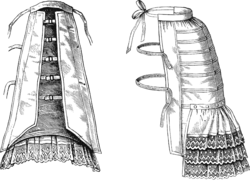
Dimity is a collective term for figured cloths of harness loom decorated with designs and patterns. It is a strong cotton cloth with various stripes and illustrations. It is bleached or washed after looming, less often dyed, unlike fustian, which is usually dyed.[1]
It is a lightweight, sheer cotton fabric, having at least two warp threads thrown into relief to form fine cords. It is a cloth commonly employed for bed upholstery and curtains, and usually white, though sometimes a pattern is printed on it in colors.[2] Originally dimity was made of silk or wool, but since the 18th century it has been woven almost exclusively of cotton.